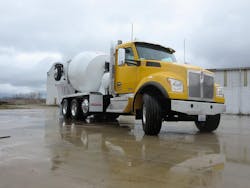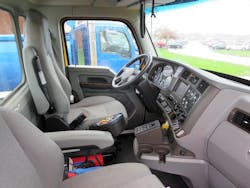Kenworth T880S Offers Traditional Looks, Handy Maneuvering
A forward-set steer axle is usually a means of stretching a truck’s wheelbase to meet weight-distribution laws in so-called bridge formula states, and that’s the reason for Kenworth’s new vocational T880S. But its brawny, flat-faced styling has sparked interest from users who simply like its looks, said builder officials during a ride-and-drive event last spring at Kenworth’s plant in Chillicothe, Ohio.
Click here for specifications for the Kenworth T880S trucks we Field Tested.
Driving on streets near the plant showed a surprisingly tight turning radius, given the wide-base wheels and tires on the steer axles of demonstration trucks: a chrome yellow five-axle concrete mixer and a bright blue four-axle dump, examples of the prime applications for the T880S. It will eventually replace the vocational W900S in KW’s product lineup.
The sharp turnability was immediately evident on the first turn I took in the mixer, which soon showed that 90-degree corners were no problem. Past KWs with a forward-placed steer axle that I’ve observed and driven were somewhat ungainly in tight turns, whether traveling forward or while backing. I once ordered a load of stone to establish shoulders along my asphalt driveway and watched as the driver of a W900S with a long slinger body backed and pulled forward four times just to get lined up at the entrance. I’d guess that a new T880S would do that with just one or two pull-ups. Drivers will certainly welcome the better maneuverability that eases work and saves time.
A major reason it turns well through corners is an offset in the front wheels, which puts tires farther from the frame and steering gear and allows a tighter wheel cut, said Kurt Swihart, KW’s director of marketing. Steering gear is still outside the frame rails, which can be expected to block a tight cut, but not here. Wheel cut is about 40 degrees, versus the 50 degrees that’s common with a setback steer axle shod with narrower wheels and tires.
Both rode well. The mixer drum was empty, so there was some bouncing on bowed pavement as the 20,000-pound front axle and suspension was lightly burdened. We kept the McNeilus drum spinning slowly to avoid flattening its support rollers while underway.
The dumper, with about 10 tons of sand in its bed, was understandably steadier; also, its 20,00-pound steer axle sat on 16,000-pound springs, which were more forgiving while running over rough pavement. The axle is a recently released Paccar-branded product, and the 16,000-pound springs are also a recent offering, Swihart said. Several axle and spring options are offered for the new model to suit individual operating needs.
Like the current axle-back T880, the S-model uses the roomy 2.1-meter-wide cab instead of the narrower cab of the T800 and W900 series. The demo trucks were comfortably trimmed and outfitted, with touches of bright-metal trim around gauges and in the HVAC knobs, and padded panels on doors and walls. They had an altogether premium feel even though the Diamond VIT (for very important trucker) package in both is no longer top-of-the-line as it was decades ago.
These are deluxe demo and display trucks, while those built for real-life hauling—especially mixers—will likely get more spartan trim. What remains standard is the solidness of a Kenworth. Part of that is tightly sealed doors: It’s almost a tradition that a driver has to crack open a KW’s window to let air escape so the door will close and latch on the first try; but it’s easier with the wide cab because it has a relief valve that allows interior air pressure to equalize with that outside the cab.
The T880S went into limited production at Chillicothe in spring, and should eventually account for about 20 percent of T880-series business, officials said. Three different settings for BA, or distance from the front bumper to the center of the steer axle, are available. The setback axle on the current T880 is more usable for running within weight laws of most states, but even there the axle-back is advantageous in multi-axle configurations, like “super” dumps and mixers with three or four pushers and a booster axle bringing up the rear.
Speaking of tradition, the 880S is the first Kenworth T-model truck with a forward-set steer axle. Previously, Ts by definition have rear-set axles and the W Series meant axle-forward. Whether the new model should be a W or a T was discussed at Kenworth’s headquarters near Seattle. Ultimately, they decided that application is more important than steer-axle placement. That follows the long-term practice at Peterbilt, KW’s sister company, where the Model 567 and the older 365 have their steer axles set forward or rearward, per weight-law requirements and customer preference.
The narrow-cab W900S, which the T880S will probably replace later this year, has a sloped hood like the venerable T800, which it strongly resembles, but a forward-set steer axle, so is something of an oddball in the lineup. Its primary use has been as a concrete mixer chassis. Also, when KW fans see “W,” they think of the long-hood W900L, the traditionally styled highway hauler. Putting all vocational trucks under the T banner makes more sense for KW planners, and probably for customers. No matter what it’s called, drivers should really like Kenworth’s latest model.


